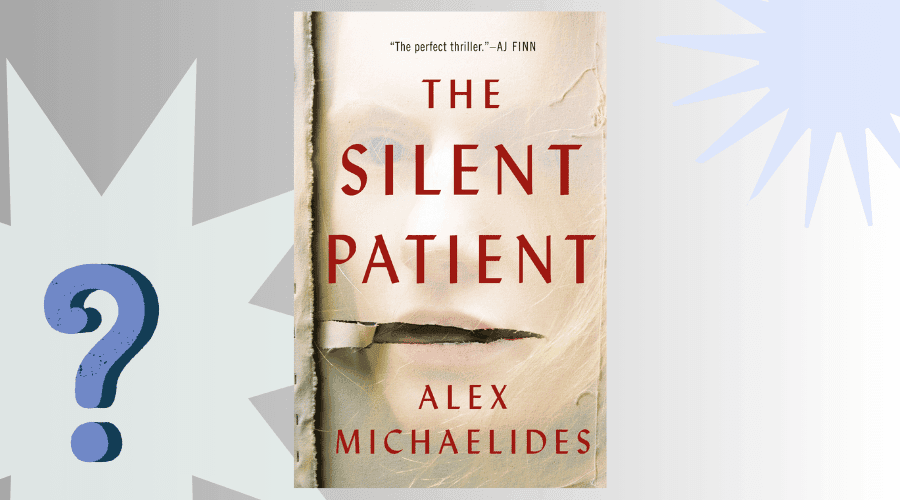The Silent Patient is an excellent choice for a book club, as it’s packed with themes and twists that can be discussed vividly. It opens deep discussions on morality and human behavior due to the exploration of mental health, trauma, and betrayal, while the narration-one that is unreliable-keeps people guessing. That shocking twist at the end will surely provide “OMG” reactions and theories; it’s definitely going to be the highlight of your meeting. Easy prose, short chapters, and fast action will make it palatable but engaging for all members. Added to that are the Greek mythology references and symbolism in Alicia’s painting Alcestis, for those who especially enjoy dissecting deeper meanings. Just be aware of the dark themes, such as violence and infidelity, that might not be to everyone’s taste. In sum, it is a true page-turner that your club will still be discussing well after the meeting adjourned!
20 The Silent Patient Book Club Questions
These questions will help your book club dive into the deeper themes, characters, and twists that make The Silent Patient such a gripping read:
- What were your initial impressions of Alicia? Did you sympathize with her, or did you find her cold and distant at first? How did your feelings toward her evolve as you learned more about her past and motivations?
- The Greek myth of Alcestis plays a central role in the novel. How does Alicia’s painting of Alcestis reflect her feelings and experiences? Do you think the myth added depth to her character or the story as a whole?
- Alicia’s childhood was deeply traumatic, particularly her father’s cruel wish that she had died instead of her mother. How do you think this early trauma influenced her relationship with Gabriel and her eventual silence?
- Theo narrates the story, but as the plot unfolds, it becomes clear he’s not entirely trustworthy. Did you sense early on that something was off about Theo, or did the reveal at the end completely surprise you?
- Theo’s obsession with Alicia starts as professional curiosity but quickly crosses boundaries. How do you feel about his ethical decisions as a psychotherapist? At what point did his behavior become irredeemable to you?
- Gabriel is portrayed as a charming yet deeply flawed character. How did your perception of him change as his betrayal was revealed? Did you feel any sympathy for him, or was he entirely to blame for the tragedy that unfolded?
- The book alternates between Theo’s first-person narration and Alicia’s diary entries. How did this structure affect your reading experience? Did it build suspense effectively, or did it make you trust one perspective over the other?
- The twist at the end is a defining moment in the novel. Were you completely shocked by it, or did you pick up on any subtle clues earlier in the story? How did the twist change your understanding of the characters and events?
- Alicia expresses herself through silence and art, particularly her self-portrait, Alcestis. Do you think these were deliberate choices for control and communication, or simply a way to cope with her trauma? How does art serve as her voice?
- Theo claims he wanted to save Alicia, but his actions reveal a more selfish agenda. Do you think Theo truly believed he could help her, or was his obsession always about himself and his unresolved pain?
- The supporting characters at The Grove, like Diomedes, Yuri, and Christian, each have their own perspectives on Alicia’s case. How did their actions and insights shape your understanding of the story? Were there any characters you wanted to know more about?
- Kathy, Theo’s wife, plays a key role in his descent. While her infidelity is a betrayal, do you think her actions were understandable given her relationship with Theo? How does her affair with Gabriel connect her to Alicia’s story?
- The setting of The Grove—a psychiatric facility—is integral to the novel’s atmosphere. Did the portrayal of The Grove feel realistic to you? How did the setting enhance the story’s tension and sense of isolation?
- Alicia’s painting Alcestis symbolizes her experience and emotions. How did you interpret the painting? Do you think it was her way of explaining what happened without words, or did it serve another purpose?
- Alicia’s silence can be seen as both a form of control and a way to cope with her trauma. Do you think it was her only way of protecting herself, or was it also a form of rebellion against a world that misunderstood her?
- Themes like betrayal, trauma, obsession, and control are central to the novel. Which theme stood out to you the most, and why? How do these themes connect the characters and their decisions?
- If you could ask Alicia one question, what would it be? Do you think she would ever break her silence to answer it? What about Theo—what would you want to know about his motivations?
- The book’s ending leaves some questions unresolved. Do you think justice was served for Alicia and Gabriel, or did the ending feel too ambiguous? What do you think happened to Theo after the truth was exposed?
- Mental health and therapy are major aspects of the story, particularly with the exploration of trauma and its impact. Did you find the portrayal of mental health and therapy realistic, or were there parts that felt exaggerated for dramatic effect?
- The Silent Patient has been compared to other psychological thrillers like Gone Girl and The Girl on the Train. How does it compare in terms of pacing, twists, and character development? What do you think makes this book stand out in the genre?
How to Host a Book Club for The Silent Patient
The Silent Patient is a perfect book club pick, packed with themes and twists that are guaranteed to spark lively discussions. Here’s how to make your meeting engaging and unforgettable:
1. Set the Mood
Create an atmosphere that mirrors the suspenseful and psychological tone of the novel. Use dim lighting, candles, or soft, eerie background music to set the stage. Since Alicia is a painter, you can incorporate art into your setting by displaying paintings or providing small canvases for members to sketch their thoughts or interpretations of the book.
2. Start with First Impressions
Begin the discussion by asking open-ended questions like, “What did you think of the book overall?” or “How did you feel about the characters?” This allows everyone to share their initial reactions and warms up the group for deeper conversations.
3. Dive into the Twist
Dedicate time to discuss the shocking twist at the end of the novel. Ask questions like:
- “Did you see the twist coming?”
- “What clues hinted at Theo’s true role in the story?”
- “How did the twist change your perception of the characters?”
The twist will likely be a hot topic, so plan enough time to explore everyone’s thoughts and theories.
4. Explore Themes
The book is rich with themes that invite analysis and discussion. Some ideas include:
- Trauma: How did Alicia’s and Theo’s past traumas shape their decisions and actions?
- Betrayal: How do the betrayals in the story (both personal and professional) drive the plot?
- Control: Was Alicia’s silence a way to regain control over her life, or was it purely a coping mechanism?
These topics will lead to thought-provoking conversations about the motivations and psychology of the characters.
5. Discuss Symbolism
Alicia’s painting Alcestis and its connection to Greek mythology are central to the story’s depth. Discuss what the painting symbolizes and how it reflects Alicia’s emotional journey. You might also explore how art and silence function as her forms of communication and rebellion.
6. Debate the Characters
The morally ambiguous characters in The Silent Patient are perfect for discussion. Use prompts like:
- “Do you sympathize with Theo, Alicia, or neither?”
- “Was Theo’s obsession driven by guilt, a need for control, or something else?”
- “How did Gabriel’s flaws contribute to the tragedy, and did he deserve his fate?”
This kind of debate often leads to lively and engaging exchanges.
7. Compare with Similar Books
Bring up other psychological thrillers, such as Gone Girl, The Girl on the Train, or Verity. Ask questions like:
- “How does The Silent Patient compare to other books in the genre?”
- “What makes it stand out in terms of pacing, characters, or twists?”
Comparing the book to others can add another layer to the discussion.
8. Incorporate Activities
To make the meeting more interactive, try these activities:
- Silent Reactions: Have members write down their immediate thoughts about the twist or ending and share them one by one.
- Guess the Motives: Ask members to “profile” Alicia and Theo before diving into the truth.
- Art Activity: Provide art supplies and have members sketch something that represents the book to them—whether it’s a scene, a symbol, or a feeling.
9. Pair with Thematic Snacks
Add a fun touch by serving Greek-inspired snacks like hummus, pita bread, olives, and baklava to tie in with the book’s references to Greek mythology.
10. Wrap Up with Final Thoughts
Close the discussion by asking members to rate the book and share their key takeaways. End with a creative, open-ended question like, “If there were a sequel, what aspects of the story or characters would you want to explore further?”
Final Advice
Be mindful of the book’s darker themes, such as mental health, violence, and betrayal, and create a space where members feel comfortable sharing their thoughts. With its suspenseful plot, complex characters, and unforgettable twist, The Silent Patient is sure to leave your book club buzzing long after the meeting ends!

